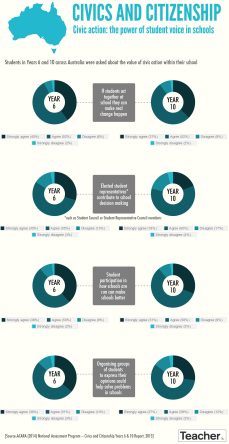Australian students' positive attitudes towards civic information, ideas and action, Indigenous cultures, and diversity have increased further according to new National Assessment Program – Civics and Citizenship (NAP-CC) data, released today.
However, when it comes to civics and citizenship knowledge, skills and understanding, national results for the 2016 test cycle show Year 6 student performance remained stable and Year 10 student performance fell.
The NAP-CC sample tests are held on a rolling three-yearly cycle, rotating with Science and ICT Literacy. More than 5600 Year 6 students from 336 schools across the country and more than 4750 Year 10 students from 308 schools across the country sat the latest Civics and Citizenship assessment in October and November last year.
The report released by ACARA (the Australian Curriculum, Assessment and Reporting Authority) reveals 38 per cent of Year 10 students achieved at or above the proficient standard – significantly lower than the 44 per cent who achieved the standard in 2013 and 49 per cent who achieved it in 2010. At the national level in 2016, 55 per cent of Year 6 students achieved at or above proficient standard, up from 52 per cent in 2013 and 2010.
Female students outperformed their male counterparts nationally at both year levels – 60 per cent of female Year 6 students reached the proficient standard, compared to 50 per cent of male Year 6 students; in Year 10 the percentages were 42 per cent for female students and 35 per cent for male students.
There were also achievement gaps between Indigenous and non-Indigenous students nationally. In Year 6, 20 per cent of Indigenous students reached the proficient standard compared to 56 per cent of non-Indigenous students; the percentages for Year 10 were 17 and 39, respectively.
In Australia, Civics and Citizenship is a sub-strand of Humanities and Social Sciences for Years 3-6 and a distinct curriculum subject for Years 7-10. The ACARA report says the ‘knowledge, skills and understanding associated with active and informed citizenship are essential for all Australians in the [21st Century] ...' It adds, ‘while it is reassuring to see that Year 6 results have remained stable, the Year 10 finding should be viewed as a chance for jurisdictions and schools to reflect upon the civics and citizenship learning opportunities provided in their schools and to take measures to address the decline.'
What does the proficient standard mean?
The NAP-CC proficient standard represents a challenging but reasonable expectation for students. The proficient standard for Year 6 is Level 2 and above on the measurement scale. Students working at this level can, for example: identify the role of the Prime Minister; recognise the role of voters in a representative democracy; recognise why a fair society needs to be based on rules and law; recognise changes in our national identity over time; and recognise that respecting the right of others to hold differing opinions is a democratic principle.
The proficient standard in Year 10 is Level 3 and above. Students working at Level 3 can, for example: justify reasons for restrictions to free speech; identify benefits of volunteering to the individual and the community; identify that sites of historic significance belong to the whole community; recognise some key functions and features of the parliament such as defining the role of the speaker of the House of Representatives; and recognise the key feature of the separation of powers in Australia.
Student attitudes, values and behaviours
In addition to assessing student achievement, the NAP-CC sample test cycle includes a survey, conducted for ACARA by staff from the Australian Council for Educational Research (ACER), measuring students' perceptions of citizenship, attitudes towards civic-related issues, and their civic engagement.
‘Two of the citizenship behaviours rated as most important by students were making personal efforts to protect natural resources (e.g. water-saving, recycling, ethical shopping) and voting in elections. Each of these behaviours was rated as very or quite important by more than 80 per cent of students in Year 6 and in Year 10,' the report says.
When asked about their trust in civic institutions, the highest levels were reported for the police (90 per cent in Year 6 and 75 per cent in Year 10) and law courts (80 per cent in Year 6 and 70 per cent in Year 10). The lowest levels of trust were for social media (37 per cent in Year 6 and 29 per cent in Year 10), the media (56 per cent and 37 per cent) and Australian political parties (65 per cent and 44 per cent). The largest difference between the two year groups was seen for the percentage of students expressing trust in the Australian Parliament (76 per cent in Year 6 and 53 per cent in Year 10).
‘Among both Year 6 and Year 10 students, about nine out of ten students endorsed the notion that Australia should support the cultural traditions and languages of Indigenous Australians (about 95 per cent in Year 6 and 94 per cent in Year 10),' the report reveals. ‘Similar levels of agreement were found for the importance of recognising traditional ownership of land (94 per cent in Year 6 and 92 per cent in Year 10) and giving everyone a chance to learn about reconciliation between Indigenous and non-Indigenous Australians (92 per cent in Year 6 and 91 per cent in Year 10). The statement that Australia has a responsibility to improve the quality of life of Indigenous Australians was endorsed by 92 per cent among Year 6 students and 88 per cent among Year 10 students.'
For the first time in NAP-CC, the 2016 cycle asked students to consider the extent to which a set of problems affect Australia. Students in both year groups considered pollution as the biggest problem, followed by climate change and unemployment.
Perhaps unsurprisingly, given the use of mobile devices, the biggest shift in behaviour compared to previous NAP-CC surveys was the proportion of students accessing news of current events from the internet – up 16 percentage points for Year 10 and 19 percentage points for Year 6 since 2013.
Students were also asked about their participation in civic and citizenship-related activities. In Year 6, 83 per cent of students said they represented their school in activities outside of class, 78 per cent were involved in peer support programs, and 75 per cent had voted for class representatives. Just over a half (51 per cent) had been on an excursion to parliaments, local governments or law courts but less than half (45 per cent) said they helped to make decisions about how the school was run. At Year 10, 76 per cent of students represented their school in activities outside class, 62 per cent participated in community activities and 59 per cent voted for class representatives. Only 46 per cent were involved in peer support programs and one-third said they had helped make decisions about how their school is run.
Discussing the implications of the NAP-CC 2016 results and survey findings, the report says teachers, schools and education systems should ‘use the structures and approaches contained within the Australian Curriculum, including strategies and methodologies that draw upon contemporary interests and approaches to learning, to leverage the positive attitude which exists towards civic information, ideas and actions,' adding, ‘this will equip present-day young Australians with the skills, values, attitudes and knowledge to be effective twenty-first century citizens and future leaders of Australia.'
Click on the link to access the full report. (PDF 4.2MB)



